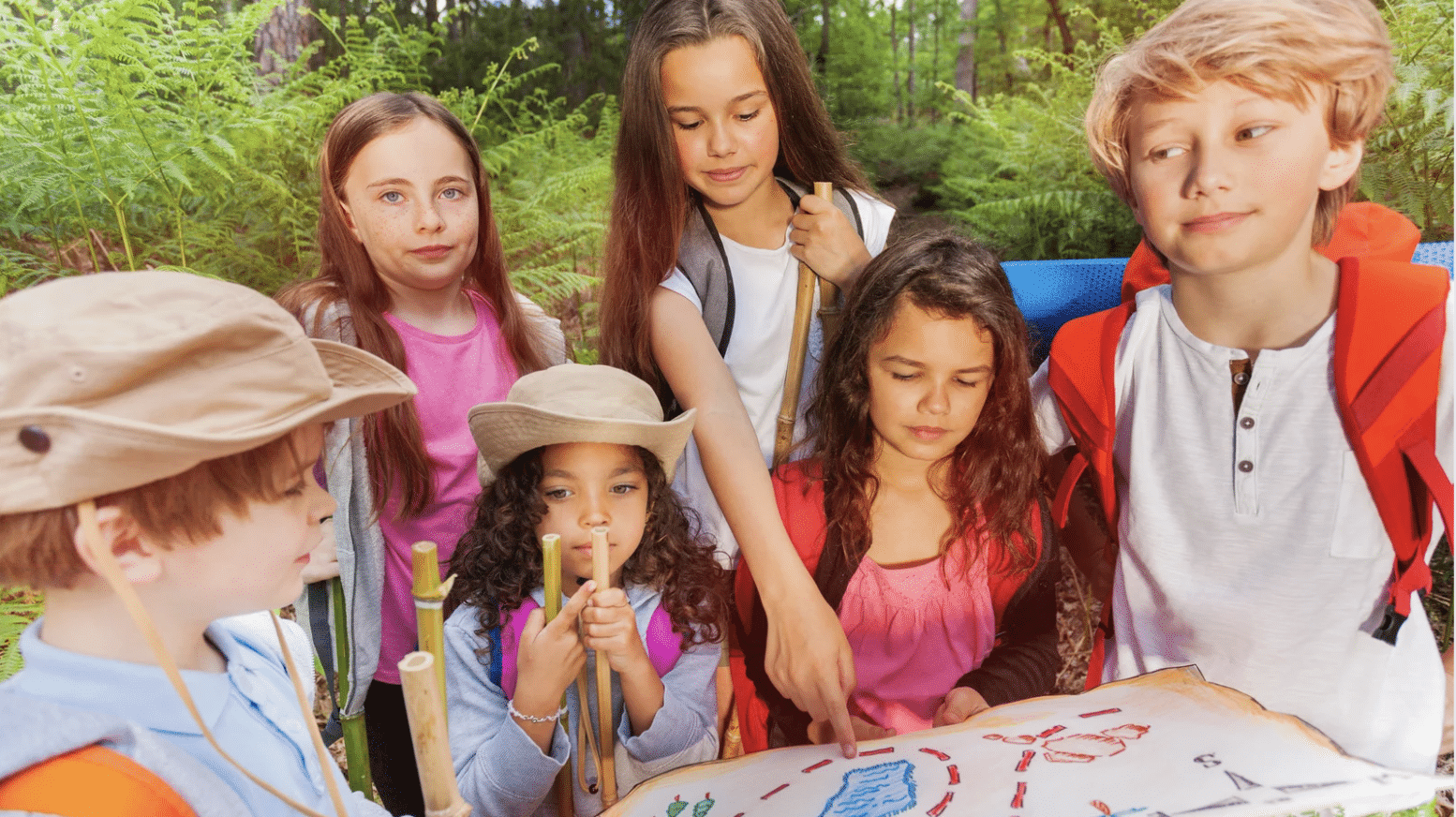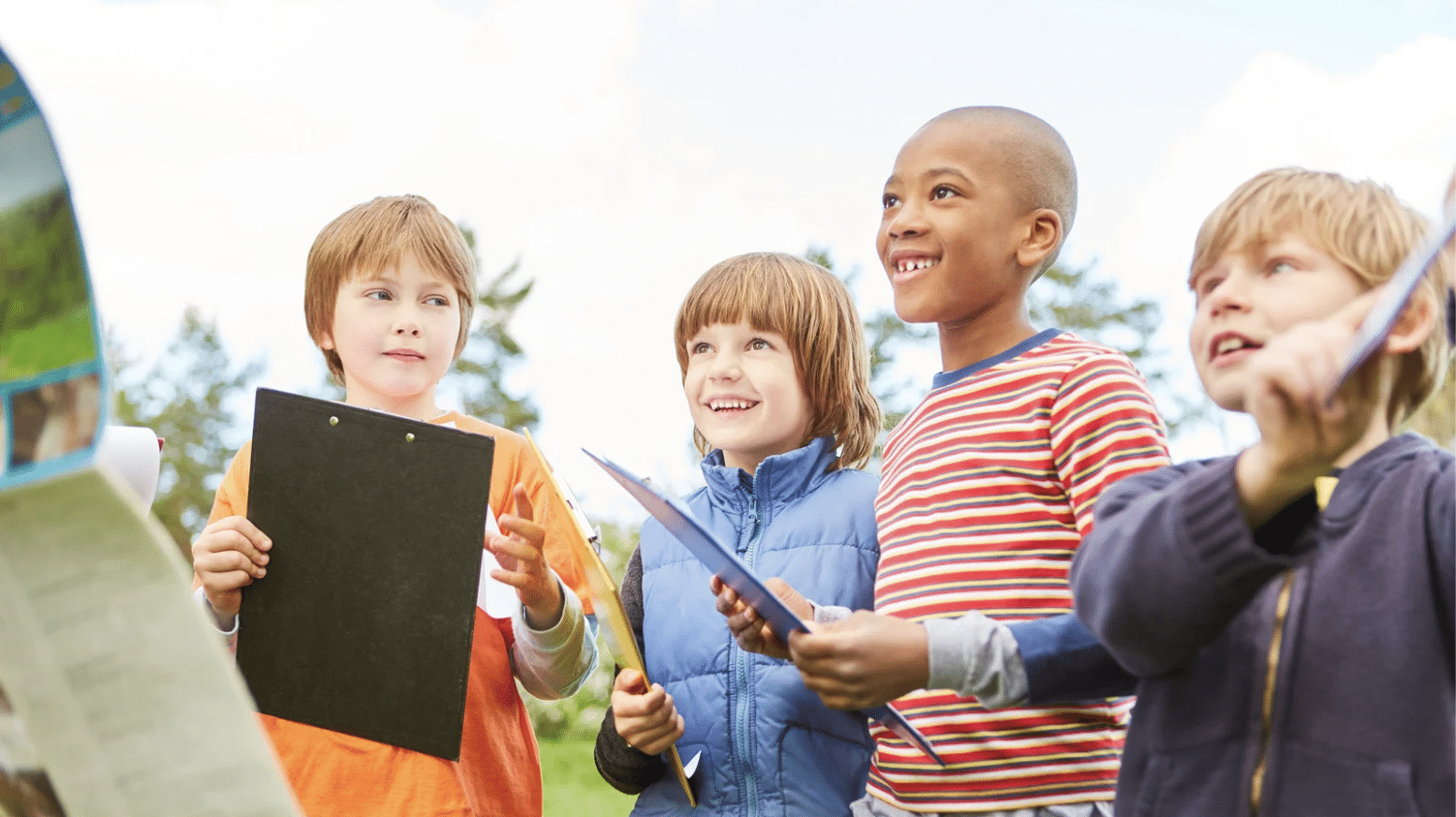I love scavenger hunts because they turn any space into an adventure. You don’t need fancy supplies or weeks of planning. A simple list of items can turn your backyard, a park, or even your living room into a game kids will never forget.
I’ll tell you everything you need to know to set up your own outdoor scavenger hunt for kids, and give step-by-step instructions, supply checklists, fun ideas for different settings, age-based variations, sample clues, and even free printable lists.
I’ll also share tips to make hunts educational, safe, and easy to host at parties or school events. By the end, you’ll be ready to create a scavenger hunt that fits your space and your kids.
How to Do an Outdoor Scavenger Hunt for Kids
An outdoor scavenger hunt is easy to set up and a lot of fun for kids. With a little planning, you can turn any park, backyard, or neighbourhood into a fun zone.
Step-by-Step Guide
Follow these simple steps to set up your scavenger hunt:
- Pick a location – Choose a safe outdoor space like your yard, a park, or a trail.
- Set boundaries – Make sure kids know where they can and cannot go.
- Create a list – Write down items to find. These can be leaves, rocks, or simple objects in the area.
- Decide the rules – Keep it clear and fair. Explain how long they have and what counts as “found.”
- Start the hunt – Hand out the lists or clues and let the kids begin their search.
Once the hunt ends, gather everyone to check items together. You can also give out small prizes or let kids share what they found.
Supplies Checklist
You don’t need much to get started, but having a few basics will make it easier:
- Printed lists or scavenger hunt cards
- Pencils, markers, or crayons for checking items
- Small bags, buckets, or baskets to collect things
- Timer or phone to keep track of time
- Optional – prizes like stickers or small toys
Having these supplies ready keeps the hunt organised and fun from start to finish.
Safety & Supervision Tips
Keeping kids safe is the most important part of any scavenger hunt. Here are a few things to remember:
- Always keep children in sight. If the space is big, assign adults to different areas.
- Remind kids not to touch unsafe items like sharp sticks, mushrooms, or insects.
- For younger kids, stick to simple items that are easy to spot nearby.
- If playing near roads or public places, set clear no-go zones.
A little preparation goes a long way. With the right rules and supervision, kids can enjoy the hunt while staying safe.
Outdoor Scavenger Hunt Ideas For Kids

There are many ways to set up an outdoor scavenger hunt, and the best part is that you can adapt it to your space and what your kids enjoy.
Nature hunts are a favourite for backyards, parks, and hiking trails. Kids can search for pinecones, bugs, colorful leaves, or flowers, which encourages them to notice small details in the world around them.
If you want something closer to home, a neighbourhood hunt is perfect. Children can look for cars, signs, fences, or even garden decorations while playing in their street.
For trips, camping, and beach hunts, add excitement. Seashells, birds, or footprints in the sand keep kids engaged and connected to nature.
Finally, sensory hunts let kids use touch, smell, and sound, making them especially fun and simple for younger children.
Age-Appropriate Scavenger Hunt Activities for Kids
Scavenger hunts are more fun when they’re designed with age in mind. Kids of different ages enjoy different challenges, so tailoring the game helps keep everyone engaged and excited. Here are fresh ideas for each group:
Toddlers
For little ones, keep the hunt playful and safe. Try a sound hunt where they find items that make noises, like a bell or rattle. You can also have a texture search, asking them to touch and bring back something soft, rough, or smooth.
- Color Hunt – Ask them to find something blue, yellow, or orange.
- Animal Sounds Hunt – Play animal noises and have them find the matching toy or picture outdoors.
- Big vs. Small Hunt – Look for one big object (like a ball) and one tiny object (like a pebble).
- Find the Bubble – Blow bubbles and let toddlers chase and “collect” them.
- Soft vs. Hard Hunt – Pick items like a feather (soft) and a stick (hard).
- Follow the Ribbon – Lay a trail of colorful ribbons leading to a prize.
- Counting Hunt – Ask them to find two rocks or three flowers.
- Animal Toy Hunt – Hide stuffed animals or figurines in the yard for them to spot.
- Touch and Tell Hunt – Blindfold and let them touch safe items (like a pinecone or ball) to guess what it is.
Preschoolers
This age group loves movement. Add an action hunt where they must hop to the next clue or crawl under a chair to find it. You can also create a scent challenge, hiding things like a lemon slice or a cinnamon stick for them to sniff and identify.
- Shape Search – Ask them to spot triangle-shaped leaves or round stones.
- Color Match Cards – Give them cards and let them match items to the right color outdoors.
- Hop to the Spot – Place clues at different spots and they must hop to each one.
- Sound Clues – Ring a bell and let them find where the sound is hidden.
- Nature Match – Match a pinecone, feather, or flower to the picture card.
- Balance Challenge – Collect items but carry them on a spoon without dropping.
- Texture Grab – Find something bumpy, smooth, and spiky.
- Alphabet Hunt – Find items that start with A, B, or C outdoors.
- Shadow Hunt – Look for shadows of objects (like trees, swings, or their own).
Elementary Kids
Make the hunt more exciting by using secret codes that kids must solve to find their next clue. Another option is a collection hunt, where they gather sets of three similar items, like three sticks or three different kinds of leaves.
- Word Riddles – Create short rhyming riddles that lead to the next clue.
- Scavenger Bingo – Make a bingo sheet with outdoor objects like “ant hill” or “yellow flower.”
- Themed Hunts – For example, “signs of fall” or “things that fly.”
- Math Clues – Solve simple addition or subtraction to unlock the next hint.
- Treasure Map Hunt – Use a simple map with marked spots in the yard or park.
- Hidden Letters – Gather letters hidden outdoors that spell a secret word.
- Story Clues – Each item adds a part to a short story they build as they go.
- Color Pattern Hunt – Collect items in a set pattern, like red, green, red, green.
- Time Challenge Hunt – Give them 3 minutes to find as many leaves, rocks, or sticks as possible.
Tweens & Teens
Older kids enjoy a bit of strategy. Try a puzzle hunt, where each found item gives a piece of a bigger puzzle they must solve. A creative hunt also works well – challenge them to act out or photograph silly scenarios, like pretending to be a statue or recreating a movie scene.
- Photo Hunt – Take creative photos of assigned objects or poses.
- Video Challenge – Record short clips acting out silly dares like dancing by a tree.
- Mystery Bag Hunt – Collect objects to fill mystery bags with categories like “smooth,” “bright,” or “tiny.”
- Trivia Clues – Answer trivia questions before moving to the next location.
- Team Race Hunt – Break into teams and race to finish the hunt first.
- Puzzle Piece Hunt – Each item found gives a piece of a larger puzzle.
- Secret Code Hunt – Clues are written in codes like numbers or symbols to decode.
- Reverse Hunt – Give them a finished item (like a bracelet) and they must find all parts outdoors to remake it.
- Photo Re-Creation – Recreate funny poses or famous scenes with friends.
- QR Code Hunt – Hide QR codes outdoors that link to clues on their phones.
- Glow-in-the-Dark Hunt – Use glow sticks or painted rocks for nighttime fun.
- Escape Hunt – Clues lead to a “locked” box (shoebox with string) they must open using found items.
- Team Challenge Hunt – Assign roles (leader, photographer, clue solver) for team-based fun.
Fun Riddles and Clues for Kids’ Scavenger Hunts
Adding riddles and clues to scavenger hunts makes them more than just a search – it turns them into a mystery kids can solve along the way. By mixing easy, medium, and harder levels, every child gets to shine. Below are some ideas you can try:
| Difficulty | Riddle/Clue | Answer |
|---|---|---|
| Easy | “I’m round and you kick me to play.” | Ball |
| “I’m yellow and shine in the sky.” | Sun | |
| “I’m cold, sweet, and melt in your hand.” | Ice cream | |
| Medium | “I’m wet, clear, and you drink me.” | Water |
| “I’m bright and help you read at night.” | Lamp | |
| “I have four legs and a wagging tail.” | Dog | |
| Hard | “I have pages but I’m not a tree. Open me up and stories you’ll see.” | Book |
| “I’m soft, white, and float in the sky.” | Cloud | |
| “I have hands but no arms, I show you the time.” | Clock |
Making the Hunts Educational

Scavenger hunts aren’t just fun. They can also be learning tools that build skills in science, reading, math, and creativity. Here are some simple ways to add learning into the game:
Turn the hunt into a mini nature study by looking for different types of bugs, noticing weather changes like clouds, wind, or sunshine, and collecting leaves or flowers to compare their shapes. This helps kids scan the world around them and build curiosity.
Reading and writing can be part of the fun. Kids can solve riddles as clues, older children can write their own scavenger hunt lists, and you can add rhyming words or word puzzles to each clue. This adds a layer of problem-solving while keeping it playful.
Numbers and patterns fit right into a scavenger hunt. Count how many rocks, sticks, or birds kids can find, look for patterns such as stripes or spots, and sort items by size, shape, or type. This makes math practice active and engaging.
Hosting Tips & Variations
Every scavenger hunt can be adjusted to fit the space, group size, or occasion. Here are some easy ways to change things up.
- Hide toys, household items, or picture cards for indoor scavenger hunts.
- Create a color or shape hunt with everyday objects around the house.
- Let kids play solo by racing against the clock to finish their list.
- Organize group hunts with teams or pairs to build cooperation.
- Make hunts competitive with prizes for the first to finish.
- Keep hunts cooperative by completing one shared list together.
- Use themed hunts at parties to match holidays, animals, or pirates.
- Link classroom hunts to lesson topics for interactive learning.
- Set up stations with clues for field days to add movement and variety.
Conclusion
Scavenger hunts don’t have to be complicated. With a short list and a little planning, you can turn any outdoor space into a play area.
They’re flexible enough to fit toddlers, big kids, or even teens, and fun enough to work for families, classrooms, or parties.
I know parents are always looking for easy ways to keep kids active and curious. A scavenger hunt does exactly that. It’s playful, educational, and works for any age group. You don’t need to spend a lot of time or money to make it happen.
Plan your outdoor adventure today and let me know your experience in the comments section below.











